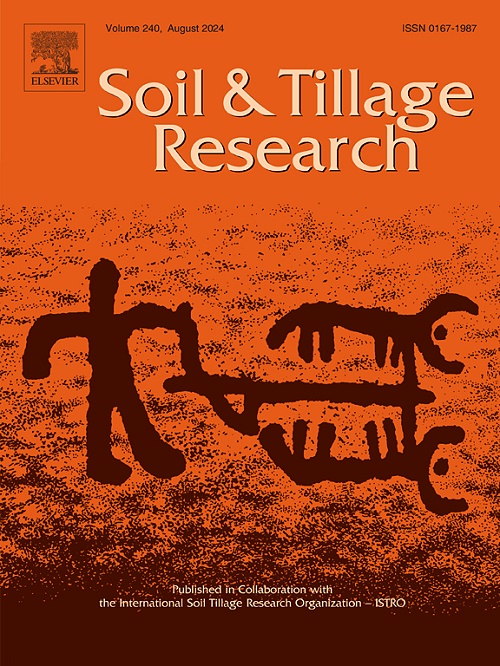Leaching salinity and mulching straws during freeze-thaw period enhance post-thawing cotton yield and quality by optimizing soil aggregates stability
IF 6.1
1区 农林科学
Q1 SOIL SCIENCE
引用次数: 0
Abstract
The salinization of arable land in Xinjiang poses a significant barrier to local agricultural development, with seasonal freeze-thaw cycles intensifying the problem of soil salinization. Implementing agronomic measures to enhance soil properties during these cycles is crucial for mitigating salinization and promoting sustainable agriculture. This study presents the results of the simultaneous application of winter irrigation and straw mulching measures in saline areas of Xinjiang. A field experiment was conducted from the end of the 2022 cotton (Xinluzao 52) growing season to the end of the 2023 season, employing three winter irrigation quotas (1800, 2400, 3000 m³ ha⁻¹) and three straw mulch thicknesses (0, 10 cm (800 kg ha⁻¹), 20 cm (1600 kg ha⁻¹)) across, along with a control check (CK) without irrigation or mulching. We evaluated the 0–40 cm soil layer for changes in aggregate distribution and stability, soil salinity, and soil organic carbon (SOC) content before and after the freeze-thaw cycle. Additionally, we analyzed differences in cotton yield quality under each plot in 2023. The results showed that combination of winter irrigation and straw mulching significantly increased the content of large-aggregates (> 2 mm) and enhanced aggregate stability, as measured by mean weight diameter (MWD) and geometric mean diameter (GWD). This combination also reduced soil salinity and increased soil organic carbon (SOC) content within the 0–40 cm soil layer during the freeze-thaw period, leading to improved cotton yield and quality in the subsequent year. Post freeze-thawing, large aggregate content, MWD, GMD, and SOC storage increased by 1.59 %-11.64 %, 1.61 %-21.61 %, 12.80 %-33.90 %, and 12.80 %-33.90 %, respectively, while salt storage decreased by 37.71 %-52.17 %. Compared to CK plots, seed cotton yield in winter irrigated and straw mulched plots increased by 844.70–2298.07 kg ha⁻¹. Pearson correlation and principal component analysis (PCA) revealed that winter irrigation combined with straw mulching enhances cotton yield and quality by increasing SOC content, reducing salinity in the tillage layer, and improving aggregate stability. Based on our findings, we recommend the application of winter irrigation and straw mulching before the freezing of saline soils in Xinjiang.
求助全文
约1分钟内获得全文
求助全文
来源期刊

Soil & Tillage Research
农林科学-土壤科学
CiteScore
13.00
自引率
6.20%
发文量
266
审稿时长
5 months
期刊介绍:
Soil & Tillage Research examines the physical, chemical and biological changes in the soil caused by tillage and field traffic. Manuscripts will be considered on aspects of soil science, physics, technology, mechanization and applied engineering for a sustainable balance among productivity, environmental quality and profitability. The following are examples of suitable topics within the scope of the journal of Soil and Tillage Research:
The agricultural and biosystems engineering associated with tillage (including no-tillage, reduced-tillage and direct drilling), irrigation and drainage, crops and crop rotations, fertilization, rehabilitation of mine spoils and processes used to modify soils. Soil change effects on establishment and yield of crops, growth of plants and roots, structure and erosion of soil, cycling of carbon and nutrients, greenhouse gas emissions, leaching, runoff and other processes that affect environmental quality. Characterization or modeling of tillage and field traffic responses, soil, climate, or topographic effects, soil deformation processes, tillage tools, traction devices, energy requirements, economics, surface and subsurface water quality effects, tillage effects on weed, pest and disease control, and their interactions.
 求助内容:
求助内容: 应助结果提醒方式:
应助结果提醒方式:


